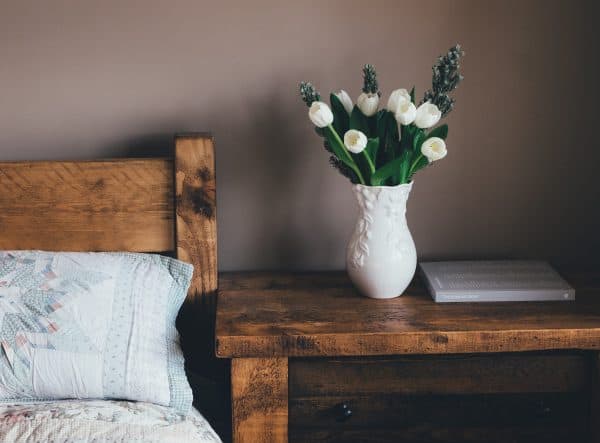Ready to learn how to declutter your home in the most effective and practical way? Let’s do this!
I think we all know we should declutter our homes at some point or other, but it’s easy to get declutter-blindness. As humans we’re very good at taking things for granted in life and our home is no exception.
You may be living in an unnecessary clutter zone right now without really noticing (although deep down you probably have noticed!).
I want you to carry out a really quick, really simple, but potentially eye-opening exercise right now (if you’re at home, otherwise next time you get home).
Stand at your front door, close your eyes and imagine you are a visitor to your home. Picture what they would be thinking and what they would be looking at when they walk in. Then open your eyes and that front door and enter your home as a visitor.
Take in everything your eye is drawn to as if it’s the first time you’ve seen it. Notice the smells that are hitting you as you walk in. What thoughts and emotions are you experiencing? Do you want all your visitors to think the same thing when they walk in?
Perhaps your home isn’t that bad, but I think it’s a good exercise to help make you aware of when it’s time to declutter.
Don’t forget to follow us on Pinterest for great Home Decor ideas.
This post may contain affiliate links. See my full disclosure here for more info.
How do you know you Need to Declutter your Home?
Aside from the above exercise, if you find yourself reading an article about how to declutter then you probably know. Oh hello there! 😉
Ok, so here are some other key signs:
- You struggle to find things a lot of the time.
- You get anxious about things being left out because it happens a lot.
- You think twice about inviting people around because of the state of your home.
- It’s become less joyful to come home because of the mess.
- There isn’t enough space for new things you bring into the house.
Anything sounding familiar? Don’t worry, you can solve all of this and end up totally transforming not only your home but your whole life! I can hear you thinking that’s just ridiculous, how can it transform your life. Well I’ll explain in the next section.
Why you Should Declutter your Home

Of the key signs above, I think the most striking is the one about being anxious when things are left out. Clutter/mess/disorganisation all cause anxiety and depression. There is no disputing this. The phrase ‘organised home, organised mind’ is incredibly apt.
You only have to have a quick 10 minute clear up in your kitchen to experience the emotional reward of tidiness. Imagine a whole house making you feel that way? Imagine walking into your home and feeling incredibly lucky to live there.
You may have come across the practice of mindfulness and how beneficial it is to your life (try this article by mindful.org to find out more). We tend to be more aware of things that are attractive to us than those that turn us off.
The same takes place in a decluttered home verses a cluttered home, so having a tidy home helps us be more mindful and therefore a step higher up the ladder of a healthy life.
Clutter can also be physically harmful by presenting trip hazards, blocking fire escape routes and making it difficult to keep your home clean.
Where to Start Decluttering your Home
Convinced and eager to get going? It is easy to get overwhelmed if there is a lot to do, but the simple way to get over this is to keep this mantra in mind ‘Even if I seem to make very little progress, it is progress nonetheless’. It also helps to do a little planning sometimes so here are your 3 steps to getting started.
Step 1: Break it down
Decluttering doesn’t need to be done in one day (although there’s nothing stopping you if you’re ambitious!). You can break it down into smaller chunks of activity to make it less daunting. The main aim should be to get one whole room done at a time so you have visual progress to spur you on further.
I recommend breaking your decluttering down to rooms, then if there is still a lot to do in a room break it further down to certain areas of a room. Don’t beat yourself up if you haven’t finished a task you aimed to get done today, sometimes it turns into a larger task than you thought. Remember, it’s all progress!
Step 2: Categorise your clutter
Have 3 boxes ready at the beginning of the task as follows: Things you want to…
- Keep, but put away
- Recycle/Throw away
- Give away
I only use 3 boxes as it I think it helps speed up the process as there is less thinking to do. These boxes are for the things you don’t want to keep in your decluttering room.
Later you might want to separate out the recycling and rubbish and also separate out the things you want to keep out, keep in storage and keep to mend or fix. You could do this sorting at the time if you’re happy to have a few more boxes out at once and want to get it all done in one go.
Step 3: Prepare to be ruthless
This is where some people might struggle. A lot of us are sentimental souls and there is nothing wrong with keeping things you are really attached to. But as a general rule you should stick to this simple formula:
- Do you love it?
- Do you need it?
Unless one of these answers is a ‘yes’, it should go in any box except the keep box. In addition if you have something you love but you don’t need ask yourself if it’s just a reminder of a memory that you love rather than the actual object.
If so, why not start a memory journal? I use the Google Keep app to write down little memories that I can flip through at will and it doesn’t take up any space! You can even take a photo of the object.
Right then, you’re all set with the right prep, the right mindset and a big cup of coffee (is it just me that functions on big cups of coffee?). Let’s get started!
Room by Room Guide to Declutter your Home
There is a good sequence to these rooms, they’re are not just in random order. Some rooms are more important to get decluttered before others, it roughly follows in order of which is used the most. Of course, this may differ person to person.
I have looked at all possible rooms you might have so just skip those that you don’t. I wont go as far as ball room or pool house though, sorry for those that have come here specifically for that!
Always keep in mind what the true purpose of the room is and try to apply that thought to anything you find in there. Also, while going through each room note down any work that needs to be done to the room either ASAP or in the future.
Bedroom

First and foremost is the bedroom. Yes, this is the most used room in the house, you spend on average a third of your life here!
It is also the most important room to feel relaxed in and you can’t do that properly with a heap of clothes surrounding your bed that you know you should do something about!
If you don’t have adequate clothes storage, get some! Preferably something that hides them away rather than those open rail systems. This room is your sanctuary, not a clothes shop.
Once you have adequate storage, put those clothes away and make sure you have a laundry basket for dirty laundry. Nobody wants to see that lying around. Then the ruthless stage. Go through all your clothes and anything that you haven’t worn in over a year, get rid of it. You’ve got through the last year without it so you’ll be fine!
Think minimalist in the bedroom. This is perhaps not the place to be collecting display items. you come in here to sleep and get it on. You just want it to be a relaxing environment. Make sure you finish by changing your bed linen and making your bed ready for a fresh start!
Introduce a regular freshening up routine. Perhaps every week or fortnight you might change your bedding, put some new flowers in a vase and have a hoover and dust. It is honestly incredible how positively a fresh, clean, relaxing bedroom affects your mentality.
Kitchen
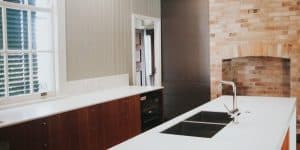
The keyword in the kitchen is organisation. You use this room heavily every day and are often using a lot of utensils, pots, pans, etc.
It is very easy for your kitchen to become cluttered so you really need a good system in place to prevent this happening
Everything must have a place of storage. If you don’t have enough storage space, then perhaps you don’t need all the things you have. Look through each cupboard and drawer and everything on your work surfaces in turn and consider every item with the following process:
- Do I use this regularly?
- Is this important for infrequent events (eg. dinner parties, Christmas)?
- Do I have space to store it out of sight?
If you answer ‘no’ to all questions then put it in your throw away or give away box (or if it’s a decent appliance you could try selling). If you’re unsure on something, put it away in a box and see if you miss it. If you don’t then get rid!
We’re guilty of hoarding tupperware here sometimes and it’s a common problem in most households. You only need enough that you can use at any one time, so what is the maximum amount of food you’re going to need to put in tupperware at once? Not as much as you think I would say. The best clutter-free way to store tupperware is to get ones that you can stack when not in use to minimise space used.
When organising your cupboards and drawers, keep things near where they will be used (eg. pots near the cooker).
Needless to say, if you can keep on top of dish washing you will go a long way to keeping your kitchen uncluttered. As with any task I tend to put off, I use this great trick.
Tell yourself that you have to start it but you can quit after a certain time if you still don’t want to do it. For washing dishes just give yourself a minute and you can quit after that if you really don’t want to do any more.
The majority of the time you will keep going; it is the getting started that is hard, not the actual task.
Home Office

I’ve put home office high up on the priority list because if you do work from home, it is definitely one of the most important rooms in the home and deserves a good decluttering routine.
It doesn’t matter what kind of person you are, you just cannot work at your full potential with a cluttered work space.
Start by completely emptying the room of everything that is not furniture or equipment (computer, printer, phone). Put back everything that you definitely use every day in your office.
Make sure there is a convenient place for each item, not just on your desk top. If it is something you use frequently throughout the day you can pull it out at the start of the day and put it away at the end of the day.
Once all these important items are in place, you can assess your storage for other things. Look at everything else that you took out of the office and go through the three- bin process. If you don’t already have a good filing system for your paperwork, receipts, etc. then get it sorted.
A good old filing cabinet is actually really useful. You could get a bog standard one and paint in your own style. The important thing is that you don’t have piles of paper you need to deal with in sight, which is always a big turn off to work.
It is a great practice to allow 5 minutes at the end of the day to tidy your work space so that you can return to a fresh, clear environment ready to get stuff done!
Living Room
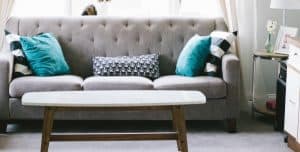
If you don’t have an all-in-one kitchen/dining/family room space, this may be the next room you spend most time in. It shares many characteristics with the bedroom in that it should be a relaxing environment, but it should also be stimulating and exciting.
I guess it’s a hard room to get right if you try and combine all of those! The main thing is that you don’t want clutter!
Do your three-bin declutter and then have a think about how you really want this room to be used. Is it purely for TV and relaxing? Is it where kids will spend most time playing? A reading room? All of the above? Let’s face it, the latter is the most likely and so it needs to work well as a multi-functional room.
There may be many things you need in this room, especially with smaller children, so good storage is vital. Try to go for storage that doesn’t look like storage, for example an upholstered ottoman for a toy box or built in cupboards for family games, a stylish sideboard.
If you have open shelves, try to only have things on them that look good. But not too many of course! Perhaps pick out some select toys for one shelf, some favourite books on another and some family photos on another. Things that emphasize what is important to your family.
When it comes to TV/games consoles/DVD/Cable boxes it goes without saying that these are all best hidden (apart from the TV maybe!). Spend a bit of time looking for a good unit to house everything, or get a local carpenter to put something bespoke together. Keep control of those cables too with spiral cable wraps and labels on the plugs so it’s not a spaghetti nightmare behind there!
The living room requires a bit of ongoing decluttering, especially as a multi-function room. Get the whole family signed up to keep this room looking spotless and everyone will enjoy it far more.
Hall/Entranceway
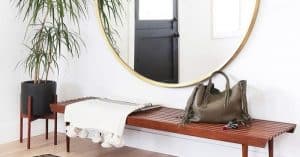
The hallway in our house is viewed as an important area. It is the first thing you see of the house, whether it’s yourself or visitors, so it should set the scene for your time there. If you don’t pay attention to your hallway it can easily just become a dumping ground.
After your three-bin declutter, make sure you can deal with everything that usually gets left in the hall. Shoes, coats, bags, keys, mail. Don’t just rely on the stair banister or side table for everything.
If you need to introduce a routine for dealing with mail, then do it and stick to it for at least a month so that it becomes a habit.
Shoes are always a big problem, they usually get strewn on the floor. Have a dedicated shoe storage place that is big enough to deal with the regular shoes and make sure the lesser used shoes are put away in bedrooms. If you have an under-stairs space you could get some shelving or drawers made up to hold all your shoes. The great example of shoe storage below wouldn’t look out of place anywhere.
Coats also present difficulties. They’re unsightly but realistically they need to be kept in the hall. You could create a mini-mudroom in your hall with a bench and hooks above (which would also give some shoe storage). We like the idea of a coat stand.
A good doormat is a must to make sure you don’t walk dirt into your house. We always go for a coir mat, but it’s something you can get creative with. Finally, get a nice reed diffuser so that your house always smells great at the first point of entrance.
Bathroom
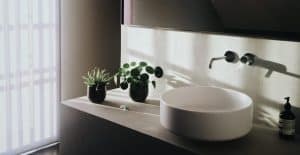
Let’s think ‘home spa’. That would be the ideal. If you can succeed in making your bathroom feels clutter-free enough to relax in as if it was a spa then you’re on to a good thing!
I think almost everyone’s bathroom contains things that are either empty, out of date, rarely used or all of the above. You’ll probably only need the throw away box in here!
Once you’ve got rid of everything that doesn’t need to be there, go for a deep clean. This is the room you come to clean yourself so you need to feel like it’s spotless when you walk in.
As with most areas, storage is king. Whether it’s a vanity unit under a basin, a shelf in the shower or a cabinet in the corner, just make sure there is somewhere to put your bits and bobs after you use them.
One thing I think is quite important in a bathroom, but that gets overlooked, is a bin/trash can. You can immediately deal with those toilet rolls, baby wipes and empty shampoo bottles so they don’t linger.
Dining Room

I think dining rooms are making a comeback, at least, I think they should be! We try to have family meals together as much as possible. It’s a time where everyone can have the audience of the rest of the family for at least a moment.
This room needs to be functional and stylish for both family meals or dinner parties. Clutter is a big no-no if you carry many plates and bowls around the table. If you don’t use your dining room enough for meals, it becomes an easy place to dump stuff (and then a convenient excuse not to eat in the dining room).
If you can get the whole family on board and do regular family meals, it increases the incentive to keep it uncluttered!
Really pair back this room so that you have your table and chairs and not much else.
Utility/Laundry Room
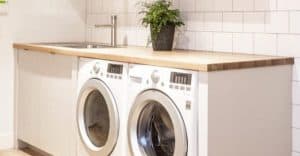
Lucky you if you have one, we’ve only just acquired space for one in our new house and it’s a godsend! But don’t fall into the trap of using it to store stuff that won’t go anywhere else (unless you have the storage space in there for it!).
This room has a purpose and you don’t want anything getting in the way.
Everything needs to have a place. This room doesn’t need to be as decor-centered as other rooms so you can use as much of the room for storage as necessary. Use the vertical wall space in the room to get cupboards all the way to the ceiling, even if you need to have a fold up step to get to them.
Everybody’s utility room will be different, but the basic principle is the same: max out on storage! You can then use any unused space for any kitchen items you want to keep, but don’t use all the time and also store cupboard food.
Playroom/Kids Bedroom
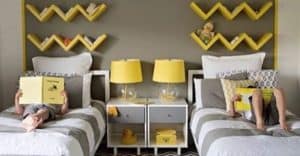
Wow, does this room have the potential to get cluttered! I’ve put this at the bottom of the list because YOU shouldn’t be decluttering this room right? I also feel it’s counter productive to keep giving kids negative feedback about their room.
All you can do is tell them they need to keep it tidy and that they may be rewarded if they do that. Kids are good at working out what’s best for them in the end!
Having said that, if you need to start over because it’s got in a state, you should get involved, but get your child helping too. Concentrate on one set of items at a time such as toys, clothes, books and artwork. If your child is old enough to make the decisions then involve them in the three-bin process, otherwise do this yourself because at a young age they will NOT want to get rid of anything!
Use a set of clothes you know fit and compare most other clothes to this so that they don’t have to try everything on. When it comes to toys you could have a ‘holder’ box that you keep some of the toys in for a month to see if they miss them and then get rid if not.
Same with books, but also consider getting your books from the library so that they get used to cycling books and are exposed to a bit more variety.
Once you have decluttered, think about your storage. Is there enough room for what you have in there now plus room for expansion? Racks of plastic drawers, such as this from Ikea, are a great, inexpensive way to keep things tidy while being accessible to the kids.
The best way to keep clutter free in the kids bedroom is to create routines with your child early on. They want to be shown what to do, and while it wont always work, it’ll take some of the heat off you at least.
Keeping Clutter Free after Decluttering
Now that you have a spotless home, how do you keep it that way? Throughout this guide, I’ve pointed out ways to introduce extra storage, create routines and keep in control.
The biggest thing to keep in mind is to do little and often. If you can keep on top of the little clutter every day (with the help of the family team!) then you shouldn’t get to the same point as you were at before this decluttering.
Whether it is just you, two of you or a whole gang, it’s healthy for everyone to be involved in daily chores to keep your home looking great. Everyone will benefit from the positive mental benefits of a clean, clutter free home.
Don’t Stop with the Inside, Declutter the Outside Too
Too soon? Why not continue the momentum and get the outside of your property looking great too, then you don’t have to wait to get inside to get the proud home feeling.
I will go into the outside in more detail in another post, but suffice to say if you’re looking out from a nice tidy home on to a terrible, cluttered garden then your anxiety will just switch from one to the other fairly quickly.
It may not need much work to get it to a state that you can be happy with, at least in the short term. It can even be a great family activity one weekend to get rid of the rubbish, mow the lawn, cut down unwanted plants and fix a fence. Perhaps even invest in a gardener for just a few hours.
Once decluttered, a good way of keeping it that way is to have a project. You could start growing tomatoes, get a nice acer tree or put up a bird table and see how many different birds come over. If you have something simple, but exciting to work on then you’ll find it easier to keep on top of other more general jobs in the garden at the same time.
I hope you’ve been able to take some useful tips and tricks from this guide and we’d love to hear of your decluttering successes. Right, I’ve got a pile of clothes in our bedroom to keep on top of!

